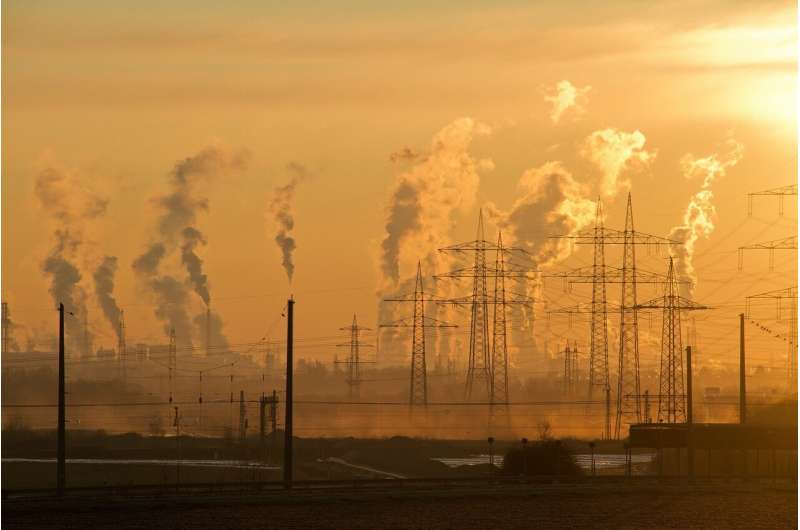This article has been reviewed according to Science X's editorial process and policies. Editors have highlighted the following attributes while ensuring the content's credibility:
fact-checked
trusted source
proofread
Government policies work to reduce greenhouse gas emissions, analysis finds

Policies designed to reduce greenhouse gas emissions have been effective, however more stringent regulations are needed to limit global warming to the Paris temperature goals, finds a new analysis by UCL researchers of international efforts to fight climate change.
The research, published in Annual Reviews of Environment and Resources, tracked the rate of greenhouse gas emissions over the last two decades against global efforts to reduce them. Since the early 2000s, governments around the world have enacted numerous regulations to curb greenhouse gas emissions.
Over the same period of time, greenhouse gas emissions have continued to increase, but the rate of annual increase has slowed in recent years from 2.3% per year between 2000 and 2010 to 1.3% per year until 2014 when it dropped to only 0.8% per year.
These policies include efforts to reduce energy use, lower the costs of clean tech, limit deforestation and promote clean energy.
The researchers find that had the world not enacted this range of climate mitigation policies, significantly more carbon dioxide would have been emitted into the atmosphere over the same period of time. They estimate that each year, between 2 to 7 billion fewer tons of carbon dioxide have been released into the atmosphere than in a world without mitigation policies, representing a decrease of 4% to 15%.
Though encouraging, the researchers warn that the reductions are insufficient to keep greenhouse gas emissions below the levels needed to reach the Paris Agreement's goal of only 1.5 to 2 degrees Celsius warming over preindustrial levels.
Co-lead author Ben Hinder (UCL Bartlett School Environment, Energy & Resources) said, "Although we found that policies have delivered on their stated goal of reducing emissions, the world remains on a path towards catastrophe. It is heartening to see that efforts so far have not been in vain, and the avoided emissions we identified demonstrate that policy has not been entirely superfluous to the slowdown in emissions growth."
"However, this still only amounts to a drop in the ocean and policy efforts must not only be dramatically expanded and deepened but also take seriously the need to stop the damage we're doing as soon as possible, for example through mandates for clean technology and bans of polluting tech."
The researchers found that policies that support the wide adoption of clean energy technology, including renewable power sources and electric vehicles, were the single biggest contributor to the decrease in emissions, leading to an estimated reduction of almost a billion tons of carbon dioxide in 2022 alone.
These policies stop carbon from being emitted at the source, which the authors say is the best way to halt climate change. Other actions such as enacting carbon pricing (which taxes the emissions of carbon dioxide), efforts to decrease deforestation, and policies to reduce energy consumption were also shown to be effective, but more limited.
In addition, international treaties were also found to be effective drivers of greenhouse gas reduction. The Kyoto Protocol, which was adopted in 1997, helped to reduce greenhouse gas emissions by 7% over its first commitment period spanning from 2008 to 2012. The ultimate impacts of the Paris Agreement, signed in 2015, are not yet apparent as it's so recent, though the researchers point to the widespread adoption of net zero targets and other policy efforts as a positive outcome.
Lead author Janna Hoppe of ETH Zürich said, "While existing efforts are vastly insufficient for limiting global warming to 1.5 degrees Celsius, three decades of mitigation policy have demonstrably lowered emissions and put us on a trajectory that makes reaching climate neutrality by mid-century a tenable goal. Climate protection efforts have not been in vain. Policies have already led to a discernible reduction in greenhouse gas emissions."
To conduct this literature review study, the researchers pulled together more than 1,500 papers, and analyzed the results from more than 300 of these studies on the effects of greenhouse gas regulation.
Senior author Professor Michael Grubb (UCL Bartlett School of Environment, Energy & Resources) said, "This exhaustive study shows that government policies and regulations can and have moved the needle on greenhouse gas emissions. Though global results have been modest so far, these path-leading successes only underline that more widespread and comprehensive policies can (and must) protect the climate."
More information: Janna Hoppe, Ben Hinder, Ryan Rafaty, Anthony Patt, and Michael Grubb, Three Decades of Climate Mitigation Policy: What Has It Delivered? Annual Reviews of Environment and Resources (2023). DOI: 10.1146/annurev-environ-112321-103821
Provided by University College London





















